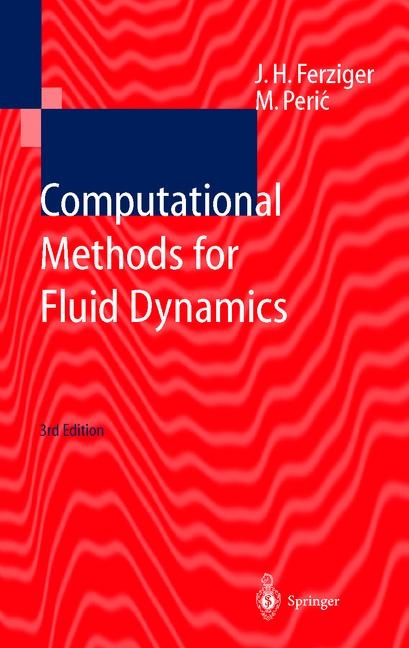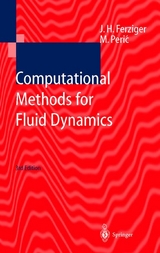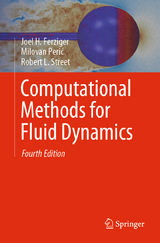Computational Methods for Fluid Dynamics
Springer Berlin (Verlag)
978-3-540-42074-3 (ISBN)
- Titel erscheint in neuer Auflage
- Artikel merken
1. Basic Concepts of Fluid Flow.- 1.1 Introduction.- 1.2 Conservation Principles.- 1.3 Mass Conservation.- 1.4 Momentum Conservation.- 1.5 Conservation of Scalar Quantities.- 1.6 Dimensionless Form of Equations.- 1.7 Simplified Mathematical Models.- 1.7.1 Incompressible Flow.- 1.7.2 Inviscid (Euler) Flow.- 1.7.3 Potential Flow.- 1.7.4 Creeping (Stokes) Flow.- 1.7.5 Boussinesq Approximation.- 1.7.6 Boundary Layer Approximation.- 1.7.7 Modeling of Complex Flow Phenomena.- 1.8 Mathematical Classification of Flows.- 1.8.1 Hyperbolic Flows.- 1.8.2 Parabolic Flows.- 1.8.3 Elliptic Flows.- 1.8.4 Mixed Flow Types.- 1.9 Plan of This Book.- 2. Introduction to Numerical Methods.- 2.1 Approaches to Fluid Dynamical Problems.- 2.2 What is CFD?.- 2.3 Possibilities and Limitations of Numerical Methods.- 2.4 Components of a Numerical Solution Method.- 2.4.1 Mathematical Model.- 2.4.2 Discretization Method.- 2.4.3 Coordinate and Basis Vector Systems.- 2.4.4 Numerical Grid.- 2.4.5 Finite Approximations.- 2.4.6 Solution Method.- 2.4.7 Convergence Criteria.- 2.5 Properties of Numerical Solution Methods.- 2.5.1 Consistency.- 2.5.2 Stability.- 2.5.3 Convergence.- 2.5.4 Conservation.- 2.5.5 Boundedness.- 2.5.6 Realizability.- 2.5.7 Accuracy.- 2.6 Discretization Approaches.- 2.6.1 Finite Difference Method.- 2.6.2 Finite Volume Method.- 2.6.3 Finite Element Method.- 3. Finite Difference Methods.- 3.1 Introduction.- 3.2 Basic Concept.- 3.3 Approximation of the First Derivative.- 3.3.1 Taylor Series Expansion.- 3.3.2 Polynomial Fitting.- 3.3.3 Compact Schemes.- 3.3.4 Non-Uniform Grids.- 3.4 Approximation of the Second Derivative.- 3.5 Approximation of Mixed Derivatives.- 3.6 Approximation of Other Terms.- 3.7 Implementation of Boundary Conditions.- 3.8 The Algebraic Equation System.- 3.9 Discretization Errors.- 3.10 An Introduction to Spectral Methods.- 3.10.1 Basic Concept.- 3.10.2 Another View of Discretization Error.- 3.11 Example.- 4. Finite Volume Methods.- 4.1 Introduction.- 4.2 Approximation of Surface Integrals.- 4.3 Approximation of Volume Integrals.- 4.4 Interpolation and Differentiation Practices.- 4.4.1 Upwind Interpolation (UDS).- 4.4.2 Linear Interpolation (CDS).- 4.4.3 Quadratic Upwind Interpolation (QUICK).- 4.4.4 Higher-Order Schemes.- 4.4.5 Other Schemes.- 4.5 Implementation of Boundary Conditions.- 4.6 The Algebraic Equation System.- 4.7 Examples.- 5. Solution of Linear Equation Systems.- 5.1 Introduction.- 5.2 Direct Methods.- 5.2.1 Gauss Elimination.- 5.2.2 LU Decomposition.- 5.2.3 Tridiagonal Systems.- 5.2.4 Cyclic Reduction.- 5.3 Iterative Methods.- 5.3.1 Basic Concept.- 5.3.2 Convergence.- 5.3.3 Some Basic Methods.- 5.3.4 Incomplete LU Decomposition: Stone’s Method.- 5.3.5 ADI and Other Splitting Methods.- 5.3.6 Conjugate Gradient Methods.- 5.3.7 Biconjugate Gradients and CGSTAB.- 5.3.8 Multigrid Methods.- 5.3.9 Other Iterative Solvers.- 5.4 Coupled Equations and Their Solution.- 5.4.1 Simultaneous Solution.- 5.4.2 Sequential Solution.- 5.4.3 Under-Relaxation.- 5.5 Non-Linear Equations and their Solution.- 5.5.1 Newton-like Techniques.- 5.5.2 Other Techniques.- 5.6 Deferred-Correction Approaches.- 5.7 Convergence Criteria and Iteration Errors.- 5.8 Examples.- 6. Methods for Unsteady Problems.- 6.1 Introduction.- 6.2 Methods for Initial Value Problems in ODEs.- 6.2.1 Two-Level Methods.- 6.2.2 Predictor-Corrector and Multipoint Methods.- 6.2.3 Runge-Kutta Methods.- 6.2.4 Other Methods.- 6.3 Application to the Generic Transport Equation.- 6.3.1 Explicit Methods.- 6.3.2 Implicit Methods.- 6.3.3 Other Methods.- 6.4 Examples.- 7. Solution of the Navier-Stokes Equations.- 7.1 Special Features of the Navier-Stokes Equations.- 7.1.1 Discretization of Convective and Viscous Terms.- 7.1.2 Discretization of Pressure Terms and Body Forces.- 7.1.3 Conservation Properties.- 7.2 Choice of Variable Arrangement on the Grid.- 7.2.1 Colocated Arrangement.- 7.2.2 Staggered Arrangements.- 7.3 Calculation of the Pressure.- 7.3.1 The Pressure Equation and its Solution.- 7.3.2 A Simple Explicit Time Advance Scheme.- 7.3.3 A Simple Implicit Time Advance Method.- 7.3.4 Implicit Pressure-Correction Methods.- 7.4 Other Methods.- 7.4.1 Fractional Step Methods.- 7.4.2 Streamfunction-Vorticity Methods.- 7.4.3 Artificial Compressibility Methods.- 7.5 Solution Methods for the Navier-Stokes Equations.- 7.5.1 Implicit Scheme Using Pressure-Correction and a Staggered GridGri.- 7.5.2 Treatment of Pressure for Colocated Variables.- 7.5.3 SIMPLE Algorithm for a Colocated Variable Arrangement.- 7.6 Note on Pressure and Incompressibility.- 7.7 Boundary Conditions for the Navier-Stokes Equations.- 7.8 Examples.- 8. Complex Geometries.- 8.1 The Choice of Grid.- 8.1.1 Stepwise Approximation Using Regular Grids.- 8.1.2 Overlapping Grids.- 8.1.3 Boundary-Fitted Non-Orthogonal Grids.- 8.2 Grid Generation.- 8.3 The Choice of Velocity Components.- 8.3.1 Grid-Oriented Velocity Components.- 8.3.2 Cartesian Velocity Components.- 8.4 The Choice of Variable Arrangement.- 8.4.1 Staggered Arrangements.- 8.4.2 Colocated Arrangement.- 8.5 Finite Difference Methods.- 8.5.1 Methods Based on Coordinate Transform ation.- 8.5.2 Method Based on Shape Functions.- 8.6 Finite Volume Methods.- 8.6.1 Approximation of Convective Fluxes.- 8.6.2 Approximation of Diffusive Fluxes.- 8.6.3 Approximation of Source Terms.- 8.6.4 Three-Dimensional Grids.- 8.6.5 Block-Structured Grids.- 8.6.6 Unstructured Grids.- 8.7 Control-Volume-Based Finite Element Methods.- 8.8 Pressure-Correction Equation.- 8.9 Axi-Symmetric Problems.- 8.10 Implementation of Boundary Conditions.- 8.10.1 Inlet.- 8.10.2 Outlet.- 8.10.3 Impermeable Walls.- 8.10.4 Symmetry Planes.- 8.10.5 Specified Pressure.- 8.11 Examples.- 9. Turbulent Flows.- 9.1 Introduction.- 9.2 Direct Numerical Simulation (DNS).- 9.2.1 Example: Spatial Decay of Grid Turbulence.- 9.3 Large Eddy Simulation (LES).- 9.3.1 Smagorinsky and Related Models.- 9.3.2 Dynamic Models.- 9.3.3 Deconvolution Models.- 9.3.4 Example: Flow Over a Wall-Mounted Cube.- 9.3.5 Example: Stratified Homogeneous Shear Flow.- 9.4 RANS Models.- 9.4.1 Reynolds-Averaged Navier-Stokes (RANS) Equations.- 9.4.2 Simple Turbulence Models and their Application.- 9.4.3 The v2f Model.- 9.4.4 Example: Flow Around an Engine Valve.- 9.5 Reynolds Stress Models.- 9.6 Very Large Eddy Simulation.- 10. Compressible Flow.- 10.1 Introduction.- 10.2 Pressure-Correction Methods for Arbitrary Mach Number.- 10.2.1 Pressure-Velocity-Density Coupling.- 10.2.2 Boundary Conditions.- 10.2.3 Examples.- 10.3 Methods Designed for Compressible Flow.- 10.3.1 An Overview of Some Specific Methods.- 11. Efficiency and Accuracy Improvement.- 11.1 Error Analysis and Estimation.- 11.1.1 Description of Errors.- 11.1.2 Estimation of Errors.- 11.1.3 Recommended Practice for CFD Uncertainty Analysis.- 11.2 Grid quality and optimization.- 11.3 Multigrid Methods for Flow Calculation.- 11.4 Adaptive Grid Methods and Local Grid Refinement.- 11.5 Parallel Computing in CFD.- 11.5.1 Iterative Schemes for Linear Equations.- 11.5.2 Domain Decomposition in Space.- 11.5.3 Domain Decomposition in Time.- 11.5.4 Efficiency of Parallel Comput ing.- 12. Special Topics.- 12.1 Introduction.- 12.2 Heat and Mass Transfer.- 12.3 Flows With Variable Fluid Properties.- 12.4 Moving Grids.- 12.5 Free-Surface Flows.- 12.5.1 Interface-Tracking Methods.- 12.5.2 Hybrid Methods.- 12.6 Meteorological and Oceanographic Applications.- 12.7 Multiphase flows.- 12.8 Combustion.- A. Appendices.- A.l List of Computer Codes and How to Access Them.- A.2 List of Frequently Used Abbreviations.- References.
| Erscheint lt. Verlag | 6.11.2001 |
|---|---|
| Zusatzinfo | XIV, 426 p. 50 illus. |
| Verlagsort | Berlin |
| Sprache | englisch |
| Maße | 155 x 235 mm |
| Gewicht | 642 g |
| Themenwelt | Mathematik / Informatik ► Mathematik ► Angewandte Mathematik |
| Technik ► Maschinenbau | |
| Schlagworte | Combustion • computational fluid dynamics • Computational Fluid Dynamics (CFD) • Design • Finite Volume Method • Fluid Dynamics • Fluiddynamik • fluid mechanics • Large Eddy Simulation • Navier-Stokes Equation • Numerical Methods • Simulation • Turbulens |
| ISBN-10 | 3-540-42074-6 / 3540420746 |
| ISBN-13 | 978-3-540-42074-3 / 9783540420743 |
| Zustand | Neuware |
| Haben Sie eine Frage zum Produkt? |
aus dem Bereich





